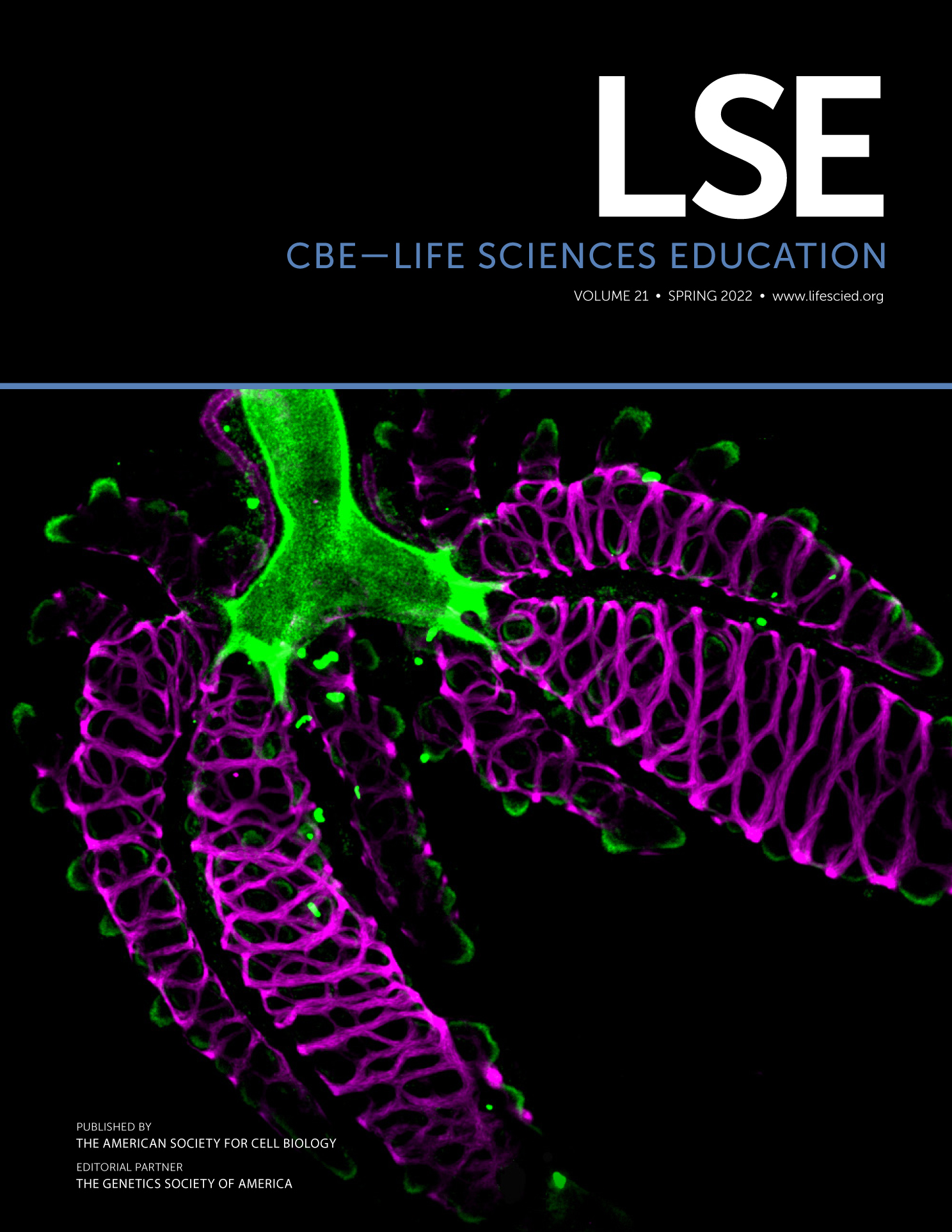A Course-Based Teaching Experience for STEM Undergraduates Improves Student Perceptions of Teaching Self-Efficacy and Attitudes Toward Teaching Careers
Abstract
There is a national need to recruit more science teachers. Enhancing pathways to teaching for science, technology, engineering, and mathematics (STEM) majors could help to address this need. The Learn By Doing Lab is a course in which STEM undergraduates teach hands-on life science and physical science to local third- through eighth-grade schoolchildren visiting the campus. To measure the impacts of this teaching experience on the undergraduate participants, we administered a version of the Science Teaching Efficacy Belief Instrument-Preservice survey at the start and end of the course. Significant gains were observed in the students’ belief in their personal ability to effectively teach science (self-efficacy). Furthermore, qualitative and quantitative analysis of student reflections revealed that they perceived the Learn By Doing Lab experience to have helped them develop 21st-century competencies, particularly in the areas of collaboration, communication, and adaptability. Finally, the students’ overall awareness and positive perception of science teaching careers increased. This indicates that providing a low-barrier course-based teaching experience for STEM undergraduates is a promising strategy to help recruit pre-service teachers, and a step toward alleviating the national STEM teacher shortage.
INTRODUCTION
There is a well-documented national need to recruit highly qualified science, technology, engineering, and mathematics (STEM) teachers (Cross, 2017; Hatch, 2018; Garcia and Weiss, 2019). Several studies support the conclusion that recruitment of STEM majors into teaching can be positively influenced by classroom experiences involving direct interaction with K–12 students and the incorporation of STEM content and pedagogy into undergraduate course work (Tomanek and Cummings, 2000; Hutchison, 2012), as well as access to programs that raise awareness of careers and opportunities in STEM education and access to faculty who discuss teaching careers (Hubbard et al., 2015; Marder et al., 2017). In addition to augmenting STEM teacher recruitment, such programs also improve science learning outcomes. Undergraduates who taught genetics to middle and high school students through a course-based service-learning program showed significant gains in content knowledge in the subjects they taught (Chrispeels et al., 2014). Similarly, undergraduates leading after-school STEM clubs reported gains in content knowledge, metacognition, and science communication skills (Ferrara et al., 2017). Positive learning outcomes are also seen in the K–12 audience. A survey of 35 Howard Hughes Medical Institute–funded STEM outreach programs saw increased science content knowledge and increased motivation to study science in the K–12 students who participated in science outreach (Felix et al., 2004).
We created the Learn By Doing Lab (LBDL) at California Polytechnic State University in San Luis Obispo, CA, to address the need to recruit and support future STEM teachers by providing a low-barrier first teaching experience (Figure 1). Our model was inspired by the Hands-On Lab program developed at California State University, Chico (Teasdale et al., 2008; Mintzes et al., 2013). The LBDL serves the undergraduate student community by providing a low-barrier teaching experience that emphasizes collaboration and provides approximately 20 hours of teaching experience. The barrier to participation is low, because the course is open to any student who has completed introductory science General Education courses and there is just one teaching event per week that occurs on campus. The LBDL serves the community by giving local third- through eighth-grade classes the opportunity to engage in STEM activities in college laboratory settings. To date, the LBDL has allowed more than 1000 STEM undergraduates to try teaching and to learn about the teaching profession while also allowing tens of thousands of children to do hands-on science activities on campus.
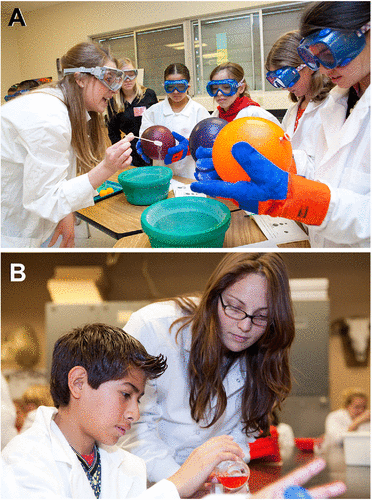
FIGURE 1. Inside the Learn By Doing Lab. SIs leading students in physical science and life science activities in the LBDL. Each year, more than 1400 local schoolchildren visit the LBDL and about 100 Cal Poly STEM majors enroll to teach hands-on science. (A) Visiting students explore temperature/volume relationships with balloons and liquid nitrogen. (B) Strawberry DNA is extracted as part of the genetics curriculum. (Credit: Chris Leschinsky. Photo release was granted by all participants.)
Our operational theory is that by offering undergraduates an opportunity to learn about teaching—by doing some teaching—we will raise awareness about careers in STEM teaching, increase self-efficacy, and ultimately increase the number of undergraduate STEM majors pursuing their teaching credentials. This study was designed to assess the impact participating in the LBDL has on undergraduates enrolled in the course. In particular, we have focused on three research questions that address our operational theory and our primary goal:
RQ1: To what extent does an LBDL teaching experience impact undergraduates’ perceptions of science teaching and their own self-efficacy?
RQ2: How do undergraduates perceive the impact of the LBDL teaching experience on life and work skills?
RQ3: What attributes of the LBDL experience do undergraduates value?
THEORETICAL BACKGROUND
Teaching Self-Efficacy
For STEM undergraduates who try teaching, persistence in that career path will be supported if their teaching experience gives them the sense that they can be effective as teachers. In general, self-efficacy is a measure of an individual’s confidence in his or her ability to successfully engage in a complex task (Bandura, 1977). In the context of science, self-efficacious teachers have confidence in their content knowledge, their ability to scaffold information appropriate for the student audience, and their ability to lead a productive discussion or inquiry-based activity. Teaching self-efficacy is known to be important beyond career persistence; a strong sense of teaching-self efficacy in pre-service teachers is associated with improved student outcomes (Deehan, 2017). Research involving elementary teachers has shown that participation in collaborative learning communities in which teachers regularly engage in peer teaching and model student-centered teaching methods can foster science self-efficacy (Briggs, 2013; Mintzes et al., 2013). Gains in science teaching self-efficacy among this group were greatest when teachers were given authentic opportunities to teach an inquiry-based science lesson to their peers or to observe others teaching skillfully.
For 30 years, the Science Teaching Efficacy Belief Instrument-Preservice (STEBI-B) has been used to determine the extent to which teaching-related programs, particularly education methods course work and credentialing programs, develop a sense of teaching self-efficacy in the pre-service teachers they serve (Enochs and Riggs, 1990; Bleicher, 2004). STEBI-B has been validated across hundreds of studies (Deehan, 2017) and has emerged as a reliable measure of teaching self-efficacy.
21st-Century Competencies
For students at every level and discipline, acquisition of so-called 21st-century competencies such as adaptability, complex communication, nonroutine problem solving, self-management, and systems thinking is important. Science is seen by many as a context for fostering development of these competencies, as many are embedded in the processes that build scientific knowledge (National Research Council [NRC], 2010). It stands to reason that teaching science, particularly in a highly collaborative environment, would be an excellent way to develop and practice many 21st-century competencies, particularly those in the domains of adaptability and complex communication and critical thinking. Life science undergraduates who taught K–8 students in a STEM outreach program showed gains in critical thinking not observed in their peers who did not participate in outreach (Nelson et al., 2018). Another model in which students of science are given opportunities to teach science is in peer teaching. Research on peer teaching in pre-health programs suggests that there are benefits both to the teachers and to the peers they mentor (Secomb, 2006). Specifically, peer teachers reported development of “professional skills,” personal satisfaction (particularly when the student:teacher ratio was low), and improved content knowledge (Bruno et al., 2016).
METHODS
This study was designed to examine the potential impacts of the LBDL teaching experience on STEM undergraduates. We applied a pre/post approach to collect self-reported survey data. Results were analyzed using a mixed-methods approach with qualitative and quantitative measures (Creswell and Creswell, 2018).
Setting
LBDL is a two-unit, quarter-long (10 week) course at California Polytechnic State University. Each quarter, undergraduates primarily from STEM majors enroll and local schools register to participate. The core experience of the LBDL is a teaching event in which approximately 100 third- through eighth-grade students visit the campus and participate in hour-long, hands-on laboratory activities led by the enrolled Cal Poly students (Supplemental Figure 1). The visiting students participate in two of these hour-long activities, one of which is typically focused on life science and another on physical science or engineering practices (representative activities and examples of LBDL materials are included in the Supplemental Material).
Typically, 20–30 undergraduate student instructors (SIs) are enrolled in one lab section of the LBDL. This group is split into two teaching cohorts who will collaborate throughout the quarter (for a timeline of the course, see Figure 2). The experience of the SIs begins with 2 weeks of preparation and practice. During this time, the SIs are introduced to the core activities they will teach and are given time to work with their peers to plan how the hour-long teaching event will proceed. For the next 3 weeks, school groups visit, and the SIs teach, reflect on, and refine the activities. In the sixth week, the two cohorts of SIs switch activities (i.e., the SIs who have taught life science for the past 3 weeks switch to teaching physical science and vice versa). No school groups visit during this transition week, providing time for the SI cohorts to share their insights on the teaching they have completed and to prepare to teach new activities. The 10-week quarter concludes with 4 weeks of school visits during which the cycle of teaching, reflecting, and refining continues. The SIs are also enrolled in a weekly, hour-long seminar that occurs separately from the teaching events. Early in the quarter, the seminar is used for planning and reflecting; as students become more confident in their lessons, the seminars are used to more formally introduce foundational teaching concepts and high-impact STEM teaching strategies.
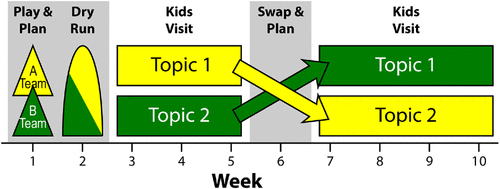
FIGURE 2. Timeline of the LBDL. The LBDL takes place during a 10-week quarter. Twenty to 30 enrolled students are initially sorted into two teaching cohorts (A team, yellow; B team, green), each of which will teach different content. The first 2 weeks are dedicated to preparation and planning with a “dry run” of the teaching activities in week 2 in which SIs present to their peers and receive feedback. In weeks 3–5, approximately 100 local schoolchildren visit, and the SIs teach the activities. The two cohorts of SIs switch content in week 6 and use that week to prepare to teach a new set of activities. Weeks 7–10 resemble weeks 3–5, with SIs teaching local schoolchildren.
For the faculty instructors (FIs) who oversee the program, the main responsibilities are to organize the group and to provide support and feedback to the SIs as they begin teaching. The FIs identify the teaching subjects before the start of the course and assemble the necessary laboratory materials. FIs divide SIs into two cohorts so they are somewhat balanced in terms of numbers, gender identity, and degree (i.e., we avoid having all the biology students together in one teaching cohort). During the 2 weeks of preparation, the FIs guide the lesson development in a way that gives the SI cohorts a sense of ownership over the material. Even though the FIs have identified the teaching subject and the core activities, most decisions about scaffolding, timing, and talking points are made collaboratively by the SI cohort.
Instrument
The original STEBI-B is a 30-item survey designed to measure the science teaching efficacy of pre-service elementary school teachers (Enochs and Riggs, 1990). Our survey instrument used the modified 23-item survey STEB-B validated by Bleicher in 2004 (Supplemental Material). Each item is rated on a five-point Likert scale ranging from “strongly disagree” to “strongly agree.” Responses are used to measure two subscales: Science Teaching Outcome Expectancy (STOE), which broadly measures attitudes about how science teaching impacts young learners; and Personal Science Teaching Efficacy (PSTE), which measures the participants’ belief about their own ability to effectively teach science. The STEBI-B is frequently used in science education and science teaching research. The STOE and the PSTE have Cronbach’s alpha reliability coefficients of 0.798 and 0.90, respectively (Deehan, 2017). Two surveys were created that included the STEBI-B items. One survey was administered before the first teaching event (the pre survey) and included questions about gender and ethnicity, family college history, and face-validated open- and closed-ended questions about career aspirations. The other survey was administered after the final teaching event of the quarter (the post survey) and included the same questions about attitudes toward teaching careers as well as open- and closed-ended reflective questions about students’ experiences teaching in the LBDL. Pre- and post-survey items included in addition to STEBI-B items were tested for face validity by the research team.
Participants and Design
One hundred students were enrolled in the LBDL in 2019 (49 in the Winter quarter and 51 in the Spring quarter). During the initial class meeting of each term, enrolled students were provided with an informed consent document approved by the University’s Institutional Review Board (Cal Poly IRB Project no. 2019-006) and a summary description of the purpose of the study and were invited to participate in this study. Participation was entirely voluntary and had no impact on students’ grades in the class. Participants were given a 1-week window, before any interaction with visiting children, to complete the online pre survey. At the end of the term, following the last group of visiting children, participants were asked to complete the online post survey.
Of the 100 students invited to participate, 68 students completed the pre survey and 54 students completed the post survey. Matched pre–post data were collected for 41 unique students. Analysis of STEBI-B data was limited to the 41 individuals for whom unique, complete pre–post data were available. In total, 81 of 100 invited students participated in the study, completing at least one survey, reflecting 81% participation. Participants were not required to respond to any demographic questions and, as such, n values will be reported for each question.
Demographically, the LBDL participants reflected the campus demographics (Figure 3) but with higher representation by women (48.41% campus-wide, 59.7% in the College of Science and Mathematics, and 72.1% in the LBDL) and by Hispanic/Latino students (17.49% campus-wide, 13.9% in the College of Science and Mathematics, and 22.4% in the LBDL). The majority of participants were from biological science degree programs, but 14 different majors were represented among the participants. The majority of participants were from the College of Science and Mathematics (COSAM), but there were participants from five different colleges within the university (Figure 3B). The majority of participants had “senior standing” (51 of 66), meaning they had completed 135 or more units of the 180 required for graduation (Figure 3C). One in four participants (17 of 68) identified as a first-generation college student (Figure 3D), while 22.4% of participants (15 of 67) identified as Hispanic or Latinx (Figure 3E). The majority of participants identified as White (51 of 68), with seven participants identifying with two or more races (Figure 3F).
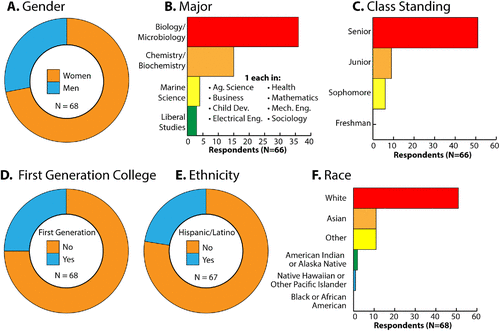
FIGURE 3. Demographics of the 2019 LBDL cohort. (A) Self-identified gender of LBDL students. (B) Major degree of LBDL students. Degrees represented by only one student are inset. (C) Class standing (level) of LBDL students. (D) First-generation college students (i.e., the first in their families to attend college) among LBDL students. (E) Ethnicity of LBDL students. Represents response to the prompt, “Hispanic/Latino; Not Hispanic/Latino.” (F) Self-identified race of LBDL students.
Data on campus-wide demographics were obtained from PolyView Report: https://content-calpoly-edu.s3.amazonaws.com/ir/1/images/Final_Poly%20View.pdf. Data on COSAM demographics were obtained from Cal Poly Institutional Research: https://ir.calpoly.edu/2019-factbook.
Statistical Analysis
Matched-pair t tests were used to analyze pre–post changes to STEBI-B subscores. A p value of 0.05 or less was used to justify rejecting the null hypothesis that pre–post subscores were unchanged. Using t values, effect size was estimated by calculating Cohen’s d. A means test was used to analyze potential normalized gains in STEBI-B subscores. A p-value of 0.05 or less was used to justify rejecting the null hypothesis that there were no gains. A McNemar-Bowker’s test was used to compare matched and paired proportions in three categories, looking at individuals’ initial and final plans to pursue a teaching career. Probability values less than 0.05 were used to reject the null hypothesis, in this case, that plans to pursue a teaching career did not change. A statistical model was developed to detect interaction effects based on reported gender, ethnicity, and first-generation status. Within our sample, we were unable to detect potential interactions between these subgroups.
Qualitative Analysis
We analyzed open-ended survey responses using a grounded theory approach to detect emergent themes (Glaser and Strauss, 1967). For each open-ended question, a minimum of two researchers examined survey responses, independently identified emergent themes, and developed a proposed coding scheme. Researchers then discussed their proposed coding schemes to develop an initial consensus strategy for each survey response. Each researcher then independently coded responses using this strategy. After independently coding responses, researchers compared their results by roughly estimating their interrater reliability (IRR), dividing the number of scoring agreements by the total number of scoring decisions (Fink, 2010). When this estimate of IRR was lower than 90%, researchers engaged in a discussion to refine their coding strategy. They then used this updated strategy to independently recode responses. This iterative process was repeated and nearly resulted in consensus coding, with IRR greater than 95% for each open-ended survey response. Researchers then identified illustrative responses that highlight emergent themes.
RESULTS
RQ1: To What Extent Does an LBDL Teaching Experience Impact Undergraduates’ Perceptions of Science Teaching and Their Own Self-Efficacy?
Attitudes of SIs enrolled in the LBDL were surveyed at the beginning and the end of the quarter using the STEBI-B. For each student, PSTE was determined to measure changes in individuals’ belief in their own, personal ability to effectively teach science (Figure 4). A significant increase in PSTE was observed in the cohort (n = 41, t = 4.99, p < 0.0001, Cohen’s d = 0.78, standardized Cronbach’s alpha coefficient = 0.56), indicating that the LBDL experience increased science teaching self-efficacy among these undergraduate students. In fact, the effect observed (Cohen’s d = 0.78) is on par with gains in teaching self-efficacy associated with a science teaching methods course intended for teaching credential candidates (Deehan, 2017). A significant increase was also observed in the STOE, which measures the students’ view of how instruction relates to student learning and performance (n = 41, t = 2.35, p = 0.024, Cohen’s d = 0.37, standardized Cronbach’s alpha coefficient = 0.76). For both PSTE and STOE, significant normalized gains were observed (PSTE: test of means, t = 5.18, p < 0.0001; and STOE: test of means, t = 1.71, p = 0.048).
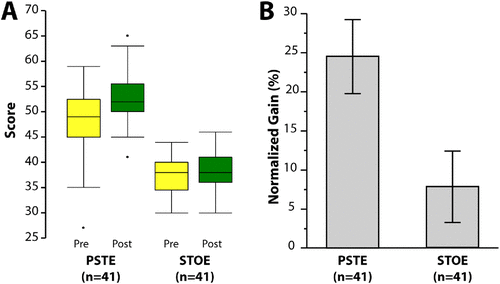
FIGURE 4. Perceptions of science teaching and self-efficacy. (A) Box-plot comparison of PSTE and STOE scores for LBDL SIs sampled at the beginning of the quarter (pre, yellow boxes) and at the end (post, green boxes) of LBDL enrollment. (B) Normalized gains for PSTE And STOE scores. Error bars represent ±1 SE around the mean.
To determine whether the LBDL experience positively impacts undergraduates’ interest in pursuing a teaching career, two closed-ended prompts were included in the pre–post LBDL survey (Figure 5). Agreement with the prompts “I could imagine becoming a teacher” and “I plan to become a teacher” both became significantly more positive in the post-survey responses compared with the pre-survey responses (McNemar-Bowker test [3-by-3], χ2 = 9.67, p = 0.021).
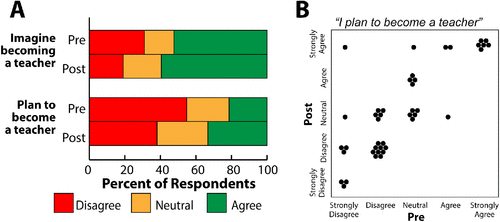
FIGURE 5. Perceptions about becoming a teacher. (A) comparisons of SI responses concerning their relationship to the teaching profession sampled at the beginning (pre) and end (post) of LBDL enrollment. Question prompts are shown to the left of the chart. (B) Shifts in individual respondents’ plans to become a teacher. Each point plots the pre–post relationship of a single student in response to the prompt “I plan to become a teacher.”
RQ2: How Do Undergraduates Perceive the Impact of the LBDL Teaching Experience on Life and Work Skills?
In 2012, the NRC shared a description of core 21st-century competencies that impact students’ future success at work and in other life areas (NRC, 2012). These competencies were categorized in three general domains: cognitive competencies, intrapersonal competencies, and interpersonal competencies. Cognitive competencies focus on the ability to think and reason. Intrapersonal competencies focus on the ability to self-manage. Interpersonal competencies focus on the ability to express and interpret information. These 21st-century competencies emerged as categories during coding of SI responses to the prompt “What skills do you feel you developed or used in the Learn By Doing Lab that might help you in ANY career?”
Overall, the categories and subcategories identified in student responses are well aligned with the 21st-century competencies described by the NRC (Figure 6). All three domains were represented to varying degrees in the SI responses. About 83% of the responders mentioned that they developed a skill that was an interpersonal competency. Within that domain, 75% said they gained teamwork and collaboration skills, including effective science communication. For example, one respondent wrote:
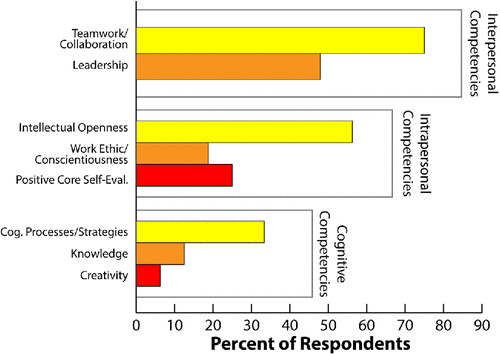
FIGURE 6. SI perception of competencies developed through the LBDL. SI responses to the open-ended prompt “What skills do you feel you developed or used in the LBDL that might help you in ANY career?” were analyzed for emergent themes. Classification of skills presented by the NRC were used. Competencies fall into three domains: interpersonal competencies, intrapersonal competencies, and cognitive competencies. Within each domain, there are two or three clusters each representing a group of related competencies; these are listed along the y-axis. The percent of respondents identifying a competency within each cluster was determined.
The importance of effective communication is amplified when working with kids. Especially younger kids, who are often more explicit than adults at conveying when they don’t understand, they helped me remember the value in articulating and stopping to check for comprehension.
About 47% said that they improved their leadership skills. One representative response was:
I feel I gained leadership and more interpersonal skills. I learned how to effectively communicate with children and how to the gain attention of an entire group. I learned how to adapt on a whim and good organization skills.
Many SIs identified development of intrapersonal competencies. About 56% of SIs said they developed intellectual openness. As a representative example, one SI shared:
Different types of explanations can be understood by different people, no question is a bad question, everyone is just trying to learn, and being able to adapt to different situations.
About 25% of students said they had a positive core self-evaluation. For example:
I’ve gained more confidence in what I know and what I can explain to others, which has helped my self-confidence as a whole. I feel that I am not as timid when I am teaching and explaining things to people.
About 38% of respondents described developing skills in the domain of cognitive competencies, including cognitive processes and strategies. For example:
How to be adaptable, how to properly engage people, how to teach by showing rather than telling, as well as cooperating with others to achieve a goal.
Additionally, SI cited the LBDL for helping them improve their work ethic, creativity (especially as it relates to science communication), and science content knowledge. Collectively, the SIs appreciated that experiences in the LBDL could positively impact future academic, professional, and social endeavors.
RQ3: What Attributes of the LBDL Experience Do Undergraduates Value?
When SIs were asked if they would recommend that a friend take the LBDL course, about 95% indicated that they would. Those SIs answering affirmatively were asked in an open-ended prompt to explain their recommendations. We view these responses as providing insights into the aspects of the LBDL that SIs themselves value, and these perspectives will likely be valuable to others seeking to implement similar courses on their campuses. The most common responses fell into four categories representing values that were intrinsic (to themselves) or extrinsic (to the visiting schoolchildren; Figure 7).
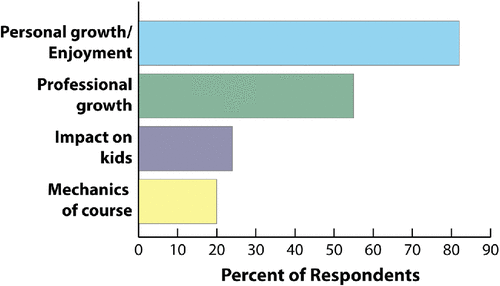
FIGURE 7. Reasons for recommending the LBDL to a friend. More than 90% of respondents indicated that they would recommend registering for the LBDL to a friend. Those replying positively were asked in an open-ended prompt to provide justification. The four most common responses are summarized in the figure.
SIs cite personal growth and enjoyment as the main reason for recommending the LBDL. For example, one SI wrote:
It is a fun class and you make great friends with your teaching groups … [the class] allowed me to re-discover why I chose a STEM major.
Another SI indicated:
This class has been an outlet of mine for relieving stress and for sparking creativity.
These two quotes and others not recorded here suggest to us that, for many SIs, the LBDL helped them appreciate their discipline and, in a few cases, energized their engagement with their degree subject in ways that their upper-division course work did not.
Other comments indicated to us that the SIs were aware that the LBDL helped them develop important skills that would benefit both their academic and professional lives. For example, one SI said:
LBDL taught me valuable interpersonal information to which my other classes didn’t expose me. I felt more capable as a result of the responsibility we were given and that feeling translated to my ability to learn in my other classes.
SIs also appreciated the potential impact the LBDL had on the visiting schoolchildren:
This class was a joy to be in and I loved every minute. Not only was it a good learning experience, but I genuinely think that I affected some of the kids’ lives.
About 20% of SIs specifically cited some aspects of course mechanics as enhancing the value of the LBDL. The built-in preparation and reflection times, the on-campus teaching events, and once-per-week evening seminar were all mentioned in SI responses. These course elements all represent conscious choices made during the development of the LBDL class (see Supplemental Material).
Overall, the emerging picture from these responses was that the SIs valued the LBDL experience, with most citing multiple elements that contributed to this view.
DISCUSSION
The LBDL was started in 2009 out of a need to provide a low-barrier teaching experience for STEM undergraduates. This experience, it was hoped, would lead to an increased awareness of teaching career pathways and improve the perception of those pathways among the participating students. By analyzing pre–post survey data, we have examined the impact of LBDL participation framed by three research questions.
RQ1: To What Extent Does an LBDL Teaching Experience Impact Undergraduates’ Perceptions of Science Teaching and Their Own Self-Efficacy?
Students who participate in the LBDL emerge with greater interest in becoming science teachers and with increased feelings of self-efficacy in science teaching. Gains in teaching self-efficacy are similar in magnitude to those observed in more formal science teaching methods courses. These are promising results. Given the well-documented need to recruit STEM teachers in the United States (Cross, 2017; Hatch, 2018; Garcia and Weiss, 2019), implementing a course-based early teaching experience like the LBDL could be part of a recruiting strategy to address this challenge.
RQ2: How Do Undergraduates Perceive the Impact of the LBDL Teaching Experience on Life and Work Skills?
SIs see the LBDL as helping them develop competencies that align closely to the NRC 21st-century competencies. In particular, competencies related to teamwork and collaboration, leadership, and intellectual openness are most cultivated by experience in the LBDL. The SIs appreciate that these competencies, developed through a science teaching experience, are applicable throughout their academic and professional lives. This insight could be helpful to faculty considering implementing a similar course, because recruiting need not be limited to students considering teaching. The course can be advertised as a way to develop competencies that are highly valued in 21st-century workspaces and can help students better prepare to enter the workforce (NRC, 2010).
RQ3: What Attributes of the LBDL Experience Do Undergraduates Value?
SIs identify both intrinsic and extrinsic reasons for valuing the LBDL experience. Intrinsically, many SIs see LBDL as providing a fun way to engage with their academic content distinct from their upper-division degree course work. Extrinsically, SIs value that the LBDL provides science content for local schoolchildren. Course mechanics, particularly the low barrier to participation in the LBDL, are also valued by the students. These results provide insights for faculty developing programs with goals similar to those of the LBDL.
In addition to the evidence presented here that students see the LBDL as improving perception of teaching careers, teaching self-efficacy, and 21st-century skill acquisition, our experience as faculty observing hundreds of students teaching in the LBDL bears out the myriad of positive gains among the SIs. Students we have known to be passive learners in their regular course work have emerged as leaders in the LBDL. Students with significant anxiety regarding public speaking have grown more comfortable speaking in front of a group. Students who had never considered teaching and enrolled in the LBDL because it “sounded like fun” have become teachers (and some have even brought their classes to Cal Poly to take part in the LBDL). There are also examples of students who were considering teaching and who, after completing LBDL, decided teaching was not a viable career path for them. For this group, LBDL provided the opportunity to explore the teaching profession in a low-stakes manner that provided useful career guidance.
We provide evidence (Figure 3) that women and Latinx students enroll in the LBDL at a rate higher than the overall demographics of the university would predict. While this study only analyzes enrollment over two 10-week quarters, our experience has shown that this enrollment pattern is typical for the LBDL across many years. Anecdotally, we can add that LBDL seems to be a magnet for first-generation college students and LGBTQIA+ students. This suggests to us that LBDL has come to be viewed as a welcoming space among a diverse group of students.
Benefits of the LBDL to the Campus and Local Community
Beyond providing a low-barrier teaching experience for undergraduates, the LBDL provides other benefits to the campus and community. For the campus, the LBDL provides an opportunity for faculty to develop content that could, potentially, be related to their research and provide significant broader impacts to research proposals. A core group of faculty from the biology and chemistry departments oversees the LBDL; however, faculty from other STEM departments are encouraged to participate, either as FIs or as content developers. The administrative systems needed to run the LBDL (i.e., student recruitment and registration, school group registration, logistics for the day of visit, etc.) are in place. Therefore, the LBDL is a low-barrier opportunity for faculty to develop science outreach activities and have them reach hundreds of local schoolchildren. To date, faculty from biology, chemistry, computer science, earth science, engineering, and physics have all developed teaching modules used in the LBDL (for descriptions of some LBDL curricular modules and examples of materials distributed to visitors, see the Supplemental Material). A benefit to the LBDL of having multiple content developers is that if students enroll in the LBDL for a second (or third or fourth!) time they are likely to be teaching new content that prevents the experience from feeling redundant.
Another benefit of the LBDL is that it provides what we believe to be a positive, high-impact field trip for children from school districts surrounding the university. In a 10-week quarter, the LBDL hosts 1400–2100 third- to eighth-grade students, typically in excess of 3500 students annually. The majority of student visitors are from high-needs districts, with a high proportion of emergent bilinguals. For many visiting students, this is the first time they have had an opportunity to visit a university campus. The LBDL is routinely praised by teachers as a highlight of the academic year. Teachers appreciate the science content, but also cite the additional benefits of bringing their students to the college campus laboratories where they interact directly with a diverse group of college students who are ambassadors for science. Studies have suggested long-term positive educational outcomes of having primary and secondary students visit college campuses, and these outcomes are especially strong for groups traditionally underrepresented in higher education (Gullatt and Jan, 2003; Hirst and Waltz, 2011; Swanson et al., 2019).
The LBDL integrates with professional development for third- to eighth-grade teachers in our region. Our COSAM has a 20-year history of supporting STEM-focused professional development for in-service teachers, most recently through the Center for Engineering, Science and Math Education (CESAME; https://cesame.calpoly.edu) and the Central Coast Science Project, a regional hub of the California Subject Matter program (https://csmp.ucop.edu). Many teachers who bring their students to the LBDL are also a part of our regional professional development community. Visits are designed to help reinforce professional development experiences and connect teachers to a durable lending library of hands-on STEM teaching materials.
CONCLUSIONS
The findings of this study indicate that a course-based science teaching experience positively affects STEM undergraduates’ perceptions of teaching careers and increases perceptions of their own science teaching self-efficacy. Student participants value the role of the LBDL experience in developing 21st-century competencies. Students derive both intrinsic and extrinsic value from the class. Together, the findings suggest that a course with a low barrier for entry in which students develop and teach science content could be an effective part of a program to recruit STEM students to teaching. (Guidance for implementing such a course can be found in Supplemental Material.) We believe that the course also provides important experiences to local schoolchildren and their teachers. Measuring the impacts of the LBDL on these populations will be a next step required to understand the full benefits of providing course-based teaching experience for STEM undergraduates.
This study focuses on the self-reported experiences of the undergraduate students enrolled in the LBDL. We have informal evidence that the LBDL has a positive impact on enrollment in the credentialing program. While the decision to enter a credentialing program is influenced by many factors and experiences, it would be interesting to collect correlational data for an initial look at the how strong a factor the LBDL was for former SIs who obtained a credential. Anecdotal feedback from teachers indicates that visiting the LBDL is positive for their students in terms of generating interest in STEM. It is important to determine the degree to which a visit to the LBDL is a formative experience for primary and secondary students in terms of motivation in STEM. Also of interest would be to investigate how the visiting schools leverage the LBDL content and curriculum after the visit.
LIMITATIONS
This study was limited by the number of participants for whom pre- and post-survey responses were available. The study was not reproduced over multiple terms with multiple FIs. Data were exclusively self-reported. To address these limitations, we could repeat the measure with alternative FIs and use what we have learned to develop an interview protocol and observational rubrics to dive more deeply into the extent to which LBDL participation is a determining factor in the choice to become a STEM teaching professional.
ACKNOWLEDGMENTS
We acknowledge the California Polytechnic State University, COSAM, especially Dean Emeritus Phil Bailey, for supporting and sustaining the Learn By Doing Lab as well as the Departments of Biological Sciences, Chemistry and Biochemistry, and Physics and the College of Engineering. We thank the California State University Mathematics and Science Teacher Initiative for supporting the Learn By Doing Lab. A.C. was supported by the William and Linda Frost Fund. We are grateful to the Center of Excellence in Science and Mathematics Education, including former director Susan Elrod and current director Chance Hoellwarth, for providing support to LBDL activities and to Jenny Cruz, Tiffany Kwapnoski, Jenny Bush, and Kaylene Wakeman for their roles in organizing the LBDL. We are grateful to faculty and staff who have brought their creativity and energy to the LBDL: Tom Bensky, Jen Carroll, John Chen, Kathy Chen, Jenny Cruz, Lynn Moody, Grace Neff, John Oliver, Kelly Polakek, Brian Rebar, Sean Ryan, and David Zigler, and others who have contributed ideas and taught in the LBDL as FIs. We thank Bev Marcum for sharing her blueprint for a course-based teaching experience and for inviting us to CSU Chico to observe the Hands-On Lab.


